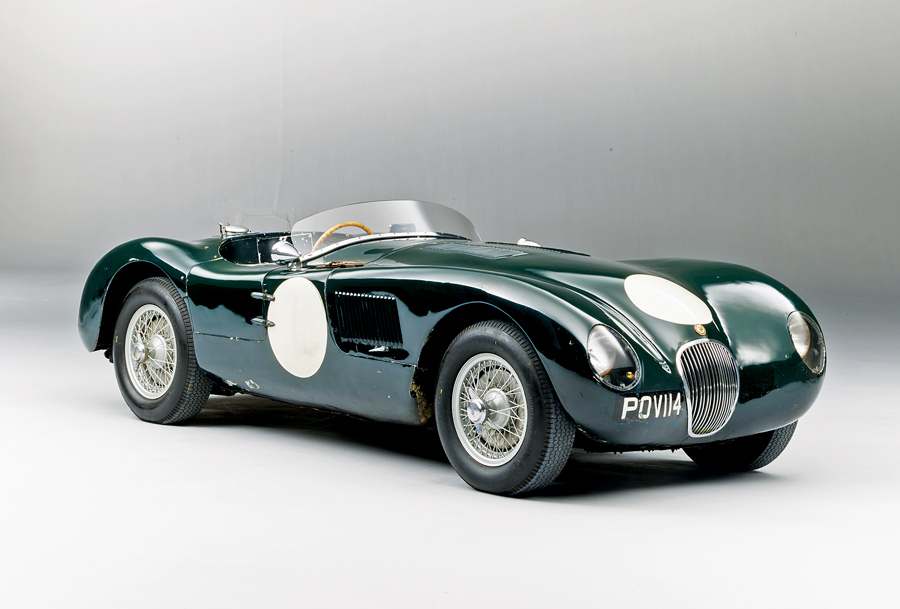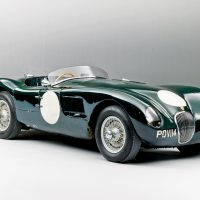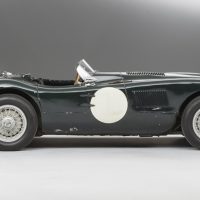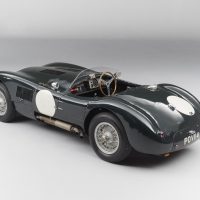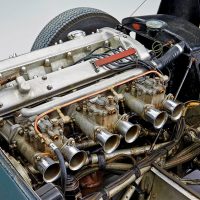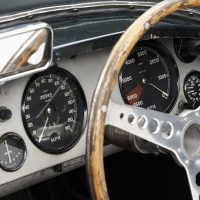SCM Analysis
Detailing
| Vehicle: | 1953 Jaguar C-Type Racer |
| Years Produced: | 1951–53 |
| Number Produced: | 53 |
| Original List Price: | $6,500 ($58,000 in 2016 dollars) |
| SCM Valuation: | Median to date: $3,250,000; high sale $13,200,000 |
| Chassis Number Location: | Top of left front suspension |
| Engine Number Location: | On head between cams |
| Club Info: | Jaguar Club of North America |
| Website: | http://www.jcna.com |
| Alternatives: | 1953 Ferrari 340 MM, 1951–53 Maserati A6GCS/53, 1953–56 Aston Martin DB3S |
| Investment Grade: | A |
This car, Lot 114, sold for $8,221,626, including buyer’s premium, at Bonhams’ Les Grandes Marques à Monaco auction on May 13, 2016.
In June of 1951, Jaguar dropped a bomb on the racing world. The expectation was that Jaguar would show up at Le Mans with a team of lightweight XK 120s, possibly lowered and using a bigger engine.
Instead they arrived with what they called the XK 120 Competition, later called the XK C — a completely new design that upstaged everything else entered. The C-type was the first modern racing car of the post-war world, and it immediately set the standards by which everything would be judged.
In its debut outing at Le Mans, the C-Type beat the previously favored Talbot-Lago by nine laps, and by the end of the season, Jaguar stood alone as the car to beat in sports car racing. The C-type was that great.
From staid to speed
Let’s do a little background, so this makes sense. Jaguar evolved out of the Swallow Sidecar Company in the 1930s as a manufacturer of upper mid-market automobiles. It was sort of an English Buick.
During World War II, they were busy doing defense work, but engineers spent their evenings thinking about what Jaguar would build when the war was over.
The first thing they were going to need was a modern engine to power things, so they set about playing with experimental concepts, labeled for the files as XA (experimental A), XB, and so on. When they got to XJ, it looked like they had a winner. It was effectively a copy of the Alfa Romeo 6C 2500 engine from just before the war — an iron block straight-six with chain-driven overhead cams and hemispherical combustion chambers in an aluminum head. By 1948, the new engine was ready for introduction, with the final version being called the XK.
Jaguar was determined to break out of their very staid, unadventurous image from before the war, and now they had the engine to do it.
For publicity’s sake, it seemed a good idea to introduce the new engine at the 1948 Earls Court automobile show in a very sexy concept sports car.
Within a few months, Jaguar managed to create a non-running — but beautiful — concept called the XK 120, which was named for the engine and how fast they thought it might go. It was an instant sensation, and Jaguar quickly decided to build 200 production examples, mostly as a way to test the new engine with customers who would be more tolerant than a luxury saloon buyer.
Well, the market loved the XK 120, and Jaguar found itself in the business of building fast sports cars.
On to Le Mans
Not only did the XK 120s sell well in the desperately needed American export market, but the cars were raced, and the halo effect from competition success was helping sell Jaguar’s bread-and-butter sedans.
In 1950, Jaguar ventured for the first time to Le Mans, the ultimate and premier automotive competition in the world. As it was their first time, Jaguar had little expectation of winning — and didn’t — but returned home with a strong feeling that they could actually do so if they put some effort into the project.
Jaguar also understood that the production XK 120 wasn’t going to be enough to win Le Mans.
They needed a racer.
Jaguar’s success at generating export revenue put them in an enviable position relative to the rest of English manufacturing, and they used the advantage to recruit a number of gifted aircraft engineers.
One was an aerodynamicist named Malcom Sayer, who was immediately given the XK 120 Competition project. The only real constraints he was given were that it must use the XK engine and drivetrain and that it should “look similar to an XK 120.” The idea of a twin-tube “ladder” chassis like Ferrari’s was quickly discarded in favor of a triangulated tubular structure built to aircraft standards, and Sayer set himself to designing a light, slippery body shape that still looked like a Jaguar.
The resulting shape had effectively the same frontal area as the XK 120, but had 22% less drag at 100 mph. It was aluminum to reduce weight.
The tubular space frame was augmented with steel bulkheads welded in to form stressed members, which doubled the torsional stiffness of the chassis and foreshadowed the monocoque structures of the D-type and E-type to come.
It is interesting to note that Jaguar’s aircraft approach considered, designed, and tested all of the engineering aspects of the new car, while Ferrari concentrated on building extraordinary engines that were set in conventional chassis and handed to various carrozzeria for bodywork. This was a classic art-vs.-science difference in approach.
To improve handling, the front suspension was similar to the XK 120, but it had revised geometry, and the rear suspension was completely different, although the live axle was retained.
Steering was made lighter and more precise with a new rack-and-pinion box that later became standard on the XK 140. Wire wheels were used because they were both lighter and improved brake cooling (how times have changed!).
The engine was improved more than altered, with bigger valves, more camshaft, some porting, and the now-iconic two-inch sandcast SU carburetors. Fuel quality was still too sketchy to raise compression very much beyond 8:1, so the engine remained amazingly docile.
The first modern sports car
The resulting “C-type” was thus the first truly modern sports racing car — and a technological tour de force in a world that was still largely working from pre-war design concepts. It was — and remains — a superb driver’s car, with (for the era) supple suspension, precise and light steering, and handling that remains predictable and friendly all the way to the limit.
As such, the C-type is a wonderful mount for a tour: I have had occasion to drive both a C-type and a 375 MM Ferrari on major tours. While the Ferrari may get more envious looks, the Jaguar is by far more fun to drive.
Rising values
When thinking about the C-type’s value and collectibility, there are a few things to keep in mind.
The first is that racing Jaguars are always emotionally valued in pound sterling, not dollars or euros, so this car sold for £5.5 million, more or less.
The second is that Jaguars have usually sold at a discount from what an equivalent Ferrari would sell for, but that discount has been narrowing over the past few years.
For years, middle-line C-types seemed to be stuck at £2.7 million (about $4 million), but they recently moved into the £3.5–£4 million
($5 million–$6 million) range. The great cars, generally defined as ones with extensive — ideally, factory racing — history and/or good originality (or in the case of today’s car, very good race history and extreme originality) tend to track more closely with Ferrari values and now range from £5 million to £9 million ($8 million to $14 million) and more for a factory lightweight with Le Mans history. Interestingly, Ferraris are always valued in dollars, so you have to convert.
Today’s car was originally thought to be a factory lightweight that had carried disc brakes at Le Mans in 1953, but careful research determined that it was in fact the Ecurie Francorchamps car instead, which badly hurt its value. On the other hand, this is a wonderful preservation car, virtually untouched and unchanged from its (not insubstantial) glory days, so selling at the lower edge of the “great C-type” range was appropriate. It was fairly bought and sold. ♦
(Introductory description courtesy of Bonhams.)
